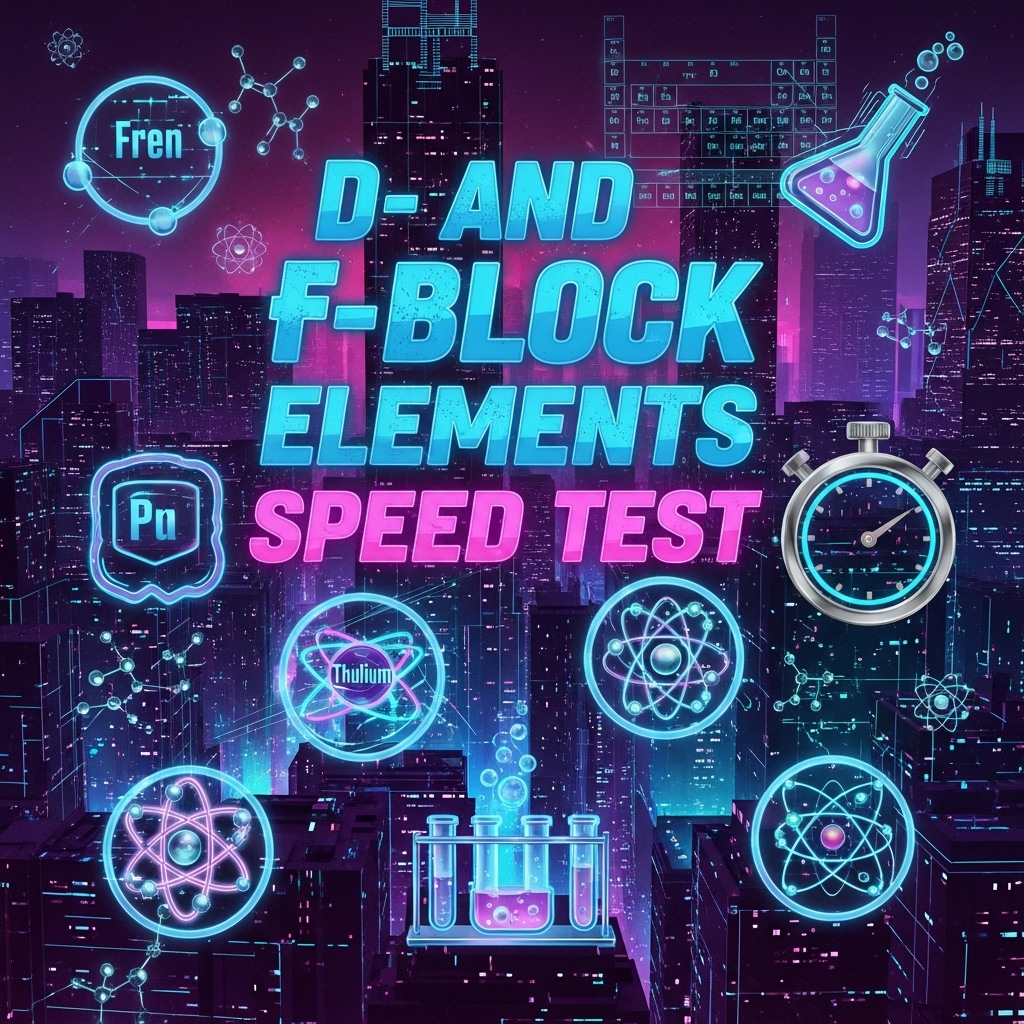d- and f-Block Elements – Interactive Quiz & Cheatsheet
Understand the transition and inner transition metals with this educational quiz
Updated: 3 months ago
Categories: Mini Game, Chemistry, Class 11, Inorganic Chemistry

D- and F-Block Elements Cheatsheet
Cheat Codes & Shortcuts
- D-Block Elements: Transition metals with valence electrons in d-orbitals (Groups 3-12).
- F-Block Elements: Inner transition metals filling f-orbitals, including Lanthanides and Actinides.
- Electron Configurations: D-block elements fill (n-1)d orbitals; f-block fill (n-2)f orbitals.
- Variable Oxidation States: Characteristic of d-block due to similar energy levels of ns and (n-1)d electrons.
- Colored Compounds: Due to d-d electronic transitions in d-block elements.
- Magnetic Properties: Unpaired d- or f-electrons cause paramagnetism.
- Lanthanide Contraction: Gradual decrease in ionic radii across lanthanides.
- Actinides: Radioactive and mostly synthetic elements with variable oxidation states.
- Complex Formation: D-block elements readily form coordination compounds.
- Catalytic Behavior: Many d-block elements act as catalysts.
Quick Reference Table
| Type | Characteristic | Example |
|---|---|---|
| D-Block | Occupy (n-1)d orbitals; variable oxidation states; colorful compounds | Fe, Cu, Ni, Zn |
| F-Block (Lanthanides) | Occupy 4f orbitals; lanthanide contraction; strong magnetic properties | La, Ce, Nd, Eu |
| F-Block (Actinides) | Occupy 5f orbitals; radioactive; many are synthetic | U, Th, Pu |
| Oxidation States | Wide range, often +2 to +7 for d-block; actinides vary widely | Cr (+3, +6), Mn (+2 to +7) |
| Magnetism | Paramagnetic due to unpaired electrons | Fe, Gd |
| Catalysis | D-block elements often used as catalysts | Pt, Pd, V₂O₅ |
Advice
Understand Electronic Configuration: Know the filling order for d and f orbitals.
Remember Lanthanide Contraction: Affects physical and chemical properties of subsequent elements.
Focus on Variable Oxidation States: Key to many chemical reactions and complex formations.
Recognize Magnetic Properties: Often related to unpaired d or f electrons.
Study Catalytic Uses: Many d-block elements are important industrial catalysts.
D- and F-Block Elements Quick Tips
- D-Block Filling: Electrons fill (n-1)d orbitals after ns orbitals.
- Variable Oxidation States: Due to closely lying s and d energy levels.
- Colored Compounds: Result from d-d electron transitions.
- Lanthanide Contraction: Causes decrease in size across lanthanides.
- f-Block Characteristics: Mostly radioactive, exhibit variable oxidation states and magnetic behavior.
D- and F-Block Elements Speed Quiz
Test your knowledge with 5 questions! You have 30 seconds per question.
Question: 1/5
Time left: 30s
Quiz Complete!
Your Score: 0/5

Group Discussions
No forum posts available.


